Zhone 6519-A2, 6519-A2-XXXX Manual
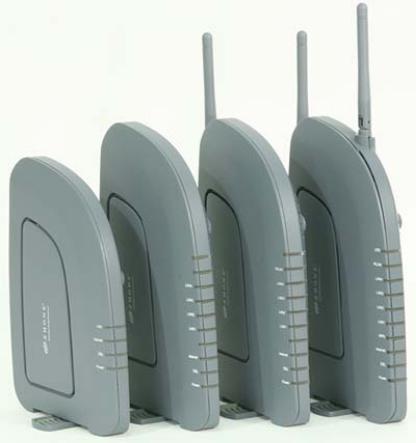
6519-X1 (4 Port)
6518-A1 (4 Port)
6512-A1 (2-Port)
6511-A1 (1-Port)
ADSL2+ Router
Users Guide
Document Part Number: 830-03750-01
June 2011

Zhone Technologies, Inc. @ Zhone Way
7001 Oakport Street Oakland, CA 94621 USA
510.777.7000 www.zhone.com info@zhone.com
COPYRIGHT ©2000-2011 Zhone Technologies, Inc. All rights reserved.
This publication is protected by copyright law. No part of this publication may be copied or distributed, transmitted, transcribed, stored in a retrieval system, or translated into any human or computer language in any form or by any means, electronic, mechanical, magnetic, manual or otherwise, or disclosed to third parties without the express written permission from Zhone Technologies, Inc.
Bitstorm, EtherXtend, IMACS, MALC, MXK, Raptor, SLMS, Z-Edge, Zhone, ZMS, zNID and the Zhone logo are trademarks of Zhone Technologies, Inc.
Zhone Technologies makes no representation or warranties with respect to the contents hereof and specifically disclaim any implied warranties of merchantability, non infringement, or fitness for a particular purpose. Further, Zhone Technologies reserves the right to revise this publication and to make changes from time to time in the contents hereof without obligation of Zhone Technologies to notify any person of such revision or changes.
This product may contain copyrighted software that is licensed under the GNU General Public License (“GPL”), a copy of which is available at www.gnu.org/licenses. You may obtain a copy of such software, in source code form, from Zhone for a period of three years after our last shipment of the product by following the instructions at www.zhone.com/gplinfo.
65xx-A1 Family Router Users Guide 2

Important Safety Instructions
1.Read and follow all warning notices and instructions marked on the product or included in the manual.
2.Slots and openings in the housing are provided for ventilation. To ensure reliable operation of the product and to protect it from overheating, these slots and openings must not be blocked or covered.
3.Do not allow anything to rest on the power cord and do not locate the product where persons will walk on the power cord.
4.Do not attempt to service this product yourself, as opening or removing covers may expose you to dangerous high voltage points or other risks. Refer all servicing to qualified service personnel.
5.General purpose cables are used with this product for connection to the network. Special cables, which may be required by the regulatory inspection authority for the installation site, are the responsibility of the customer. Use a UL Listed, CSA certified, minimum No. 24 AWG line cord for connection to the Digital Subscriber Line (DSL) network.
6.When installed in the final configuration, the product must comply with the applicable Safety Standards and regulatory requirements of the country in which it is installed. If necessary, consult with the appropriate regulatory agencies and inspection authorities to ensure compliance.
7.A rare phenomenon can create a voltage potential between the earth grounds of two or more buildings. If products installed in separate buildings are interconnected, the voltage potential may cause a hazardous condition. Consult a qualified electrical consultant to determine whether or not this phenomenon exists and, if necessary, implement corrective action prior to interconnecting the products.
8.Input power to this product must be provided by one of the following: (1) a UL Listed/CSA certified power source with a Class 2 or Limited Power Source (LPS) output for use in North America, or (2) a certified transformer, with a Safety Extra Low Voltage (SELV) output having a maximum of 240 VA available, for use in the country of installation.
9.In addition, since the equipment is to be used with telecommunications circuits, take the following precautions:
—Never install telephone wiring during a lightning storm.
—Never install telephone jacks in wet locations unless the jack is specifically designed for wet locations.
—Never touch uninsulated telephone wires or terminals unless the telephone line has been disconnected at the network interface.
—Use caution when installing or modifying telephone lines.
—Avoid using a telephone (other than a cordless type) during an electrical storm. There may be a remote risk of electric shock from lightning.
—Do not use the telephone to report a gas leak which is in the vicinity of the leak.
65xx-A1 Family Router Users Guide 3

CE Marking
When the product is marked with the CE mark on the equipment label, a supporting Declaration of Conformity may be downloaded from the Zhone World Wide Web site at www.zhone.com.
FCC Part 15 Declaration
An FCC Declaration of Conformity may be downloaded from the Zhone World Wide Web site at www.zhone.com.
This device complies with Part 15 of the FCC Rules. Operation is subject to the following two conditions: (1) this device may not cause harmful interference, and (2) this device must accept any interference received, including interference that may cause undesired operation.
The authority to operate this equipment is conditioned by the requirement that no modifications will be made to the equipment unless the changes or modifications are expressly approved by the responsible party.
This equipment has been tested and found to comply with the limits for a Class B digital device, pursuant to Part 15 of the FCC Rules. These limits are designed to provide reasonable protection against harmful interference in a residential installation. This equipment generates, uses, and can radiate radio frequency energy and, if not installed and used in accordance with the instructions, may cause harmful interference to radio communications. However, there is no guarantee that interference will not occur in a particular installation. If this equipment does cause harmful interference to radio or television reception, which can be determined by turning the equipment off and on, the user is encouraged to try to correct the interference by one or more of the following measures:
—Reorient or relocate the receiving antenna.
—Increase the separation between the equipment and receiver.
—Connect the equipment into an outlet on a circuit different from that to which the receiver is connected.
—Consult the dealer or an experienced radio/TV technician for help.
Notice to Users of the United States Telephone Network
The following notice applies to versions of the modem that have been FCC Part 68 approved.
This equipment complies with Part 68 of the FCC rules and the requirements adopted by the Administrative Council for Terminal Attachment (ACTA). On the bottom side of this equipment is a label that contains, among other information, a product identifier in the format US:AAAEQ##TXXXX. If requested, this number must be provided to the Telephone Company.
This equipment is intended to connect to the Public Switched Telephone Network through a Universal Service Order Code (USOC) type RJ11C jack. A plug and jack used to connect this equipment to the premises wiring and telephone network must comply with the applicable FCC Part 68 rules and requirements adopted by the ACTA. A compliant telephone cord and modular plug is provided with this product. It has been designed to be connected to a compatible modular jack that is also compliant.
The Ringer Equivalence Number (REN) is used to determine the number of devices that may be connected to a telephone line. Excessive RENs on a telephone line may result in the devices not ringing in response to an incoming call. In most but not all areas, the sum of RENs should not
65xx-A1 Family Router Users Guide 4

exceed five (5.0). To be certain of the number of devices that may be connected to a line, as determined by the total RENs, contact the local Telephone Company.
The REN for this product is part of the product identifier that has the format US:AAAEQ##TXXXX. The digits represented by ## are the REN without a decimal point. For example, 03 represents a REN of 0.3.
If the modem causes harm to the telephone network, the Telephone Company will notify you in advance that temporary discontinuance of service may be required. But if advance notice is not practical, the Telephone Company will notify the customer as soon as possible. Also, you will be advised of your right to file a complaint with the FCC if you believe it is necessary.
The Telephone Company may make changes in its facilities, equipment, operations or procedures that could affect the operation of the equipment. If this happens, the Telephone Company will provide advance notice in order for you to make necessary modifications to maintain uninterrupted service. If trouble is experienced with the modem, refer to the repair and warranty information in this document.
If the equipment is causing harm to the telephone network, the Telephone Company may request that you disconnect the equipment until the problem is resolved.
The user may make no repairs to the equipment.
Connection to party line service is subject to state tariffs. Contact the state public utility commission, public service commission or corporation commission for information.
If the site has specially wired alarm equipment connected to the telephone line, ensure the installation of the modem does not disable the alarm equipment. If you have questions about what will disable alarm equipment, consult your Telephone Company or a qualified installer.
Notice to Users of the Canadian Telephone Network
NOTICE: This equipment meets the applicable Industry Canada Terminal Equipment Technical Specifications. This is confirmed by the registration number. The abbreviation IC before the registration number signifies that registration was performed based on a Declaration of Conformity indicating that Industry Canada technical specifications were met. It does not imply that Industry Canada approved the equipment.
NOTICE: The Ringer Equivalence Number (REN) for this terminal equipment is labelled on the equipment. The REN assigned to each terminal piece of equipment provides an indication of the maximum number of terminals allowed to be connected to a telephone interface. The termination on an interface may consist of any combination of devices subject only to the requirement that the sum of the Ringer Equivalence Numbers of all the devices does not exceed five.
If your equipment is in need of repair, contact your local sales representative, service representative, or distributor directly.
NOTICE: This Class B digital apparatus complies with Canadian ICES-003.
Cet appareil numérique de classe B est conforme à la norme Canadienne NMB-003.
65xx-A1 Family Router Users Guide 5

CANADA - EMI NOTICE:
This Class B digital apparatus meets all requirements of the Canadian interference-causing equipment regulations.
Cet appareil numérique de la classe B respecte toutes les exigences du règlement sur le matérial brouilleur du Canada.
NOTICE: This device complies with RSS-210,IC ID:8609A-1518A1NA
Operation is subject to the following two conditions:
1)This device may not cause interference and
2)This device must accept any interference, including interference that may cause undesired operation of the device.
65xx-A1 Family Router Users Guide 6

Table of Contents |
|
|
Important Safety Instructions................................................................................................................................ |
3 |
|
CE Marking ...................................................................................................................................................... |
4 |
|
FCC Part 15 Declaration.................................................................................................................................. |
4 |
|
Table of Contents ................................................................................................................................................. |
7 |
|
About This Guide................................................................................................................................................ |
10 |
|
Style and Notation Conventions..................................................................................................................... |
10 |
|
Typographical Conventions............................................................................................................................ |
11 |
|
Acronyms |
....................................................................................................................................................... |
11 |
Contacting Customer Service and Technical Support........................................................................................ |
12 |
|
Chapter 1 |
Introduction |
13 |
System Requirements ........................................................................................................................................ |
13 |
|
Package Contents .............................................................................................................................................. |
13 |
|
Safety Instructions.............................................................................................................................................. |
13 |
|
Front Panels |
....................................................................................................................................................... |
14 |
6519-X1 Front ......................................................................................................................................Panel |
14 |
|
6518-A1 Front ......................................................................................................................................Panel |
14 |
|
6512-A1 Front ......................................................................................................................................Panel |
14 |
|
6511-A1 Front ......................................................................................................................................Panel |
15 |
|
LED descriptions............................................................................................................................................ |
15 |
|
Back Panel ......................................................................................................................................................... |
|
16 |
Chapter 2 Hardware Installation and PC Setup |
17 |
|
Overview ............................................................................................................................................................ |
|
17 |
Connecting Your ................................................................................................................................Hardware |
17 |
|
Mounting the ...........................................................................................................................................Router |
18 |
|
Unit dimensions ............................................................................................................................................. |
19 |
|
Configuring Your ................................................................................................................................Computer |
20 |
|
Windows 2000 ............................................................................................................................................... |
20 |
|
Windows XP................................................................................................................................................... |
21 |
|
Windows 7...................................................................................................................................................... |
21 |
|
Chapter 3 The Web User Interface |
22 |
|
Log in to the ............................................................................................................................................Router |
22 |
|
Summary ............................................................................................................................................................ |
|
23 |
WAN ................................................................................................................................................................... |
|
24 |
LAN Statistics................................................................................................................................................. |
24 |
|
WAN Statistics................................................................................................................................................ |
25 |
|
xTM Statistics................................................................................................................................................. |
25 |
|
xDSL Statistics ............................................................................................................................................... |
26 |
|
ADSL BER ..............................................................................................................................................Test |
26 |
|
Route.................................................................................................................................................................. |
|
27 |
ARP .................................................................................................................................................................... |
|
28 |
DHCP ................................................................................................................................................................. |
|
28 |
Chapter 4 Quick Setup |
31 |
|
Quick Setup .........................................................................................................with Automatic Configuration |
31 |
|
Quick Setup ..........................................................................................with Automatic Configuration Disabled |
32 |
|
Chapter 5 |
Advanced Setup |
39 |
|
65xx - A1 Family Router Users Guide |
7 |

Configuration Types ........................................................................................................................................... |
39 |
Add an ATM Layer 2 Interface ....................................................................................................................... |
39 |
Add an Ethernet Layer 2 Interface................................................................................................................. |
40 |
Add a Bridge WAN Service............................................................................................................................ |
41 |
Add a PPPoE WAN Service........................................................................................................................... |
41 |
Add an IPoE WAN Service ............................................................................................................................ |
43 |
Add a PPPoA WAN Service........................................................................................................................... |
45 |
Add an IPoA WAN Service............................................................................................................................. |
46 |
Remove a Connection ................................................................................................................................... |
49 |
Edit a Connection........................................................................................................................................... |
49 |
Ethernet Mode.................................................................................................................................................... |
49 |
LAN Local Area Network (LAN) Setup ............................................................................................................... |
49 |
NAT..................................................................................................................................................................... |
51 |
Virtual Servers................................................................................................................................................ |
51 |
Port Triggering ............................................................................................................................................... |
53 |
DMZ Host....................................................................................................................................................... |
54 |
ALG ................................................................................................................................................................ |
55 |
Security............................................................................................................................................................... |
55 |
IP Filtering—Outgoing.................................................................................................................................... |
55 |
IP Filtering—Incoming.................................................................................................................................... |
56 |
MAC Filtering ................................................................................................................................................. |
59 |
Parental Control ................................................................................................................................................. |
61 |
Time Restriction ............................................................................................................................................. |
61 |
URL Filter ....................................................................................................................................................... |
63 |
Quality of Service ............................................................................................................................................... |
64 |
Queue Config................................................................................................................................................. |
64 |
QoS Classification.......................................................................................................................................... |
66 |
Routing ............................................................................................................................................................... |
68 |
Default Gateway ............................................................................................................................................ |
68 |
Static Route.................................................................................................................................................... |
69 |
Policy Route................................................................................................................................................... |
70 |
RIP ................................................................................................................................................................. |
72 |
DNS.................................................................................................................................................................... |
72 |
Dynamic DNS................................................................................................................................................. |
73 |
DSL..................................................................................................................................................................... |
74 |
Modulation Methods .................................................................................................................................. |
74 |
Capability ................................................................................................................................................... |
75 |
DSL Advanced Settings ................................................................................................................................. |
75 |
UPnP .................................................................................................................................................................. |
77 |
DNS Proxy.......................................................................................................................................................... |
77 |
Print Server (6519 ONLY) .................................................................................................................................. |
78 |
Adding a printer server................................................................................................................................... |
78 |
Windows 7 ................................................................................................................................................. |
79 |
Windows XP .............................................................................................................................................. |
83 |
Interface Grouping.............................................................................................................................................. |
89 |
LAN Ports ........................................................................................................................................................... |
91 |
IPSec.................................................................................................................................................................. |
91 |
Certificate ........................................................................................................................................................... |
95 |
Local............................................................................................................................................................... |
95 |
Trusted CA ..................................................................................................................................................... |
98 |
Multicast ........................................................................................................................................................... |
100 |
Wireless (6518/6519 only)................................................................................................................................ |
100 |
Basic ............................................................................................................................................................ |
100 |
Security ........................................................................................................................................................ |
102 |
WPS setup (5618/6519 only)................................................................................................................... |
102 |
Manual Setup AP..................................................................................................................................... |
103 |
MAC Filter .................................................................................................................................................... |
112 |
Wireless Bridge............................................................................................................................................ |
114 |
65xx-A1 Family Router Users Guide |
8 |

Advanced ..................................................................................................................................................... |
116 |
Station Info ................................................................................................................................................... |
119 |
Diagnostics....................................................................................................................................................... |
119 |
Fault Management ....................................................................................................................................... |
121 |
Management .................................................................................................................................................... |
121 |
Settings ........................................................................................................................................................ |
122 |
Backup Settings....................................................................................................................................... |
122 |
Update Settings ....................................................................................................................................... |
123 |
Restore Default........................................................................................................................................ |
123 |
System Log ...................................................................................................................................................... |
124 |
Configure System Log ................................................................................................................................. |
125 |
SNMP Agent..................................................................................................................................................... |
126 |
TR-069 Client ................................................................................................................................................... |
127 |
Internet Time .................................................................................................................................................... |
128 |
Access Control ................................................................................................................................................. |
129 |
Passwords.................................................................................................................................................... |
130 |
Services ....................................................................................................................................................... |
130 |
IP Addresses .................................................................................................................................................... |
131 |
Update Software............................................................................................................................................... |
132 |
Reboot.............................................................................................................................................................. |
133 |
Tools ................................................................................................................................................................. |
133 |
Chapter 6 Troubleshooting |
136 |
The Router Is Not Functional ........................................................................................................................... |
136 |
You Cannot Connect to the Router .................................................................................................................. |
136 |
The DSL LED Continues to Blink ..................................................................................................................... |
136 |
The DSL LED is Always Off.............................................................................................................................. |
137 |
The Internet LED is Always Off ........................................................................................................................ |
137 |
Diagnosing Problems using IP Utilities ............................................................................................................ |
137 |
Ping .............................................................................................................................................................. |
137 |
Tracert.......................................................................................................................................................... |
138 |
Nslookup ...................................................................................................................................................... |
138 |
Appendix A – Glossary |
139 |
65xx-A1 Family Router Users Guide 9
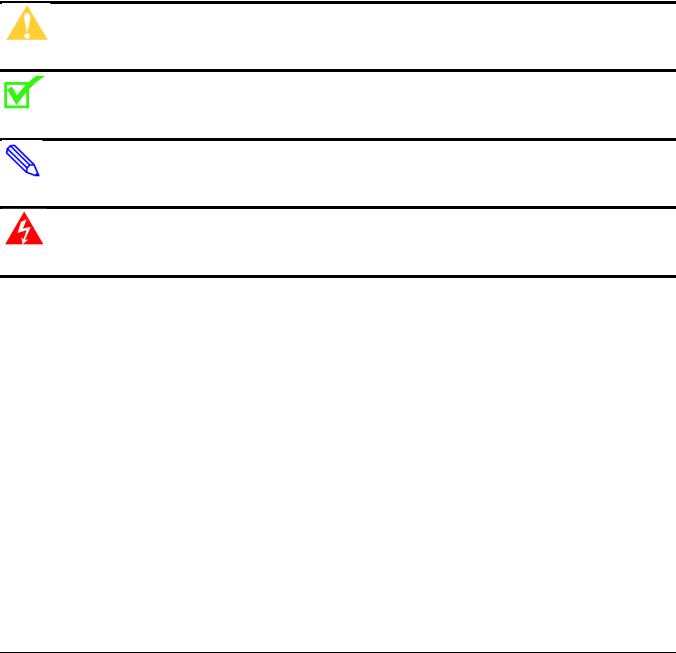
About This Guide
This guide is intended for use by installation technicians, system administrators, and network administrators. It explains how to install and configure the 6511-A1, 6512-A1 6518-A1, and 6519X1 routers.
Style and Notation Conventions
The following conventions are used in this document to alert users to information that is instructional, warns of potential damage to system equipment or data, and warns of potential injury or death. Carefully read and follow the instructions included in this document.
Caution: A caution alerts users to conditions or actions that could damage equipment or data.
Note: A note provides important supplemental or amplified information.
Tip: A tip provides additional information that enables users to more readily complete their tasks.
WARNING! A warning alerts users to conditions or actions that could lead to injury or death.
65xx-A1 Family Router Users Guide 10

Typographical Conventions
The following typographical styles are used in this guide to represent specific types of information.
Bold |
Used for names of buttons, dialog boxes, icons, menus, |
|
|
profiles when placed in body text, and property pages (or |
|
|
sheets). Also used for commands, options, parameters in |
|
|
body text, and user input in body text. |
|
|
|
|
Fixed |
Used in code examples for computer output, file names, path |
|
names, and the contents of online files or directories. |
||
|
||
|
|
|
Fixed Bold |
Used in code examples for text typed by users. |
|
|
||
|
|
|
Fixed Bold |
Used in code examples for variable text typed by users. |
|
Italic |
|
|
|
|
|
Italic |
Used for book titles, chapter titles, file path names, notes in |
|
body text requiring special attention, section titles, |
||
|
||
|
emphasized terms, and variables. |
|
|
|
|
PLAIN UPPER |
Used for environment variables. |
|
CASE |
|
|
|
|
|
Command Syntax |
Brackets [ ] indicate optional syntax. |
|
|
Vertical bar | indicates the OR symbol. |
Acronyms
The following acronyms are related to Zhone products and may appear throughout this manual:
Table 1: Acronyms and their descriptions
Acronym |
Description |
|
|
ADSL |
Asymmetrical Digital Subscriber Line |
|
|
AP |
Access Point |
|
|
ACS |
Auto Configuration Server |
|
|
DHCP |
Dynamic Host Configuration Protocol |
|
|
DSL |
Digital Subscriber Line |
|
|
EFM |
Ethernet in the First Mile |
|
|
MALC |
Multi-Access Line Concentrator |
|
|
MIB |
Management Information Bases |
|
|
NAT |
Network Address Translation |
|
|
NMS |
Network Management System |
|
|
65xx-A1 Family Router Users Guide 11

PVC |
Permanent Virtual Circuit |
|
|
RADIUS |
Remote Authentication Dial In User Service |
|
|
SHDSL |
Symmetric High-bit-rate Digital Subscriber Line |
|
|
SLMS |
Single Line Multi-Service |
|
|
SNMP |
Simple Network Management Protocol |
|
|
TFTP |
Trivial File Transfer Protocol |
|
|
VoIP |
Voice over IP |
|
|
VPN |
Virtual Private Network |
|
|
WEP |
Wired Equivalent Privacy |
|
|
Wi-Fi |
Wireless Fidelity (IEEE 802.11 wireless networking) |
|
|
WMM |
Wi-Fi Multimedia |
|
|
WPA |
Wi-Fi Protected Access |
|
|
ZMS |
Zhone Management System |
|
|
Contacting Customer Service and Technical Support
Customer service and technical support for this Zhone device are provided by your Internet Service Provider.
65xx-A1 Family Router Users Guide 12

Chapter 1 Introduction
The 6519-X1 (four port N 2X2 router with WiFi), 6518-A1 (four port N router with WiFi), 6512-A1 (four port), and 6511-A1 (one port) ADSL 2+ routers are easily installed routers which deliver the performance needed for multimedia applications
This User’s Guide will show you how to set up the routers, and how to customize the configuration to get the most out of the product.
The 65xx-A1 family provides the following features:
•ADSL2+ modem which supports ANSI T1.413 ISSUE 2, ITU G.992.1 (G.DMT), ITU G.992.2 (G.LITE), ITU G992.3, ITU G992.5, and ADSL2+ to meet different linking speeds from your ISP.
•802.11 b/g WiFi LAN port (6519/6518 only).
•DSL Dying Gasp support.
•Four 10/100BaseT Ethernet ports to provide Internet connectivity to all computers on your LAN (6518 and 6512) The 6511 has one 10/100BaseT Ethernet port.
•Easy-to-use configuration program accessible through a standard web browser.
System Requirements
In order to use your 65xx-A1 family ADSL router for Internet access, you must have the following:
•ADSL service subscription from your ISP.
•A PC with:
An Ethernet 10/100BaseT network interface card
A processor equivalent to or faster than a Pentium II 133 MHz
32 MB RAM or greater
Windows 95b, 98, 98SE, 2000, ME, NT, XP, Vista or Windows 7. (Note: Windows 95 requires the installation of the Winsock program, not included.)
•(Optional) An Ethernet hub or switch, if you are connecting the device to several computers on an Ethernet network.
•For system monitoring or configuration using the supplied web interface, a web browser such as Internet Explorer Version 6.0 or later. Netscape is not supported.
Package Contents
In addition to this document, your package should arrive containing the following:
•6519-X 1, 6518-A1, 6512-A1, or 6511-A1 ADSL 2+ router
•12V 700 mA power adapter
•RJ-11 telephone cable
•RJ-45 Ethernet cable
•User Manual / Quick Guide
Safety Instructions
Place your modem on a flat surface close to the cables in a location with sufficient ventilation.
65xx-A1 Family Router Users Guide 13
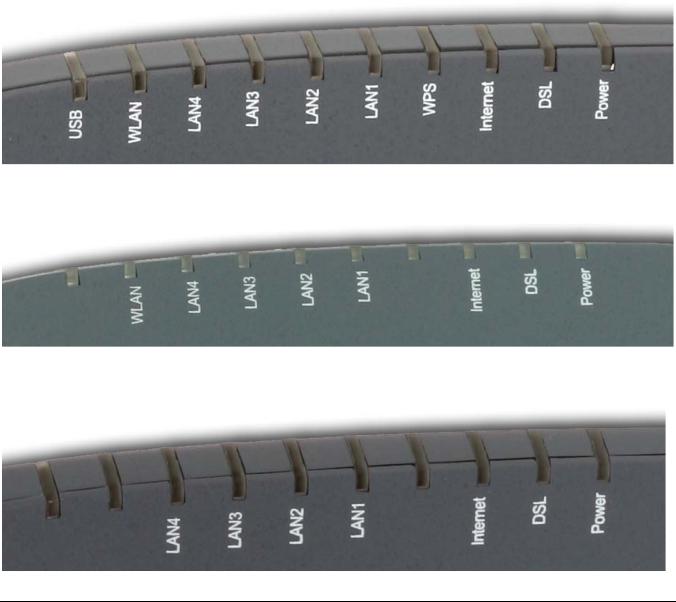
To prevent overheating, do not obstruct the ventilation openings of the device.
Plug the device into a surge protector to reduce the risk of damage from power surges and lightning strikes.
Operate this equipment only from an electrical outlet with the correct power source as indicated on the adapter.
Do not open the cover of the device. Opening the cover will void any warranties on the equipment.
Unplug equipment first before cleaning. A damp cloth can be used to clean the equipment. Do not use liquid / aerosol cleaners or magnetic / static cleaning devices.
Front Panels
6519-X1 Front Panel
6518-A1 Front Panel
6512-A1 Front Panel
65xx-A1 Family Router Users Guide 14

6511-A1 Front Panel
LED descriptions
|
LED |
|
Mode |
|
INDICATION |
|
|
|
|
|
|
|
|
|
Solid green |
|
Boot-up successful |
|
Power |
|
Solid red |
|
Router is booting up |
|
|
|
|
The router may not be turned on. Check if the power adapter is |
|
|
|
|
|
|
|
|
|
|
No light |
|
connected to the modem, the modem is plugged in and the power |
|
|
|
|
|
switch button is in the on (pushed in) state. |
|
|
|
Solid |
|
Connection established. The router is able to communicate with |
|
DSL |
|
|
your ISP via ADSL |
|
|
|
|
|
||
|
|
|
Flashing |
|
The router is attempting to connect to your ISP |
|
|
|
Solid |
|
ADSL is connected |
|
Internet |
|
No light |
|
ADSL is not connected. The ALARM LED will be red |
|
|
|
Blinking |
|
The router is connected to the LAN |
|
|
|
Solid on |
|
Ethernet interface is successfully connected to a device through |
|
LAN 1-4 |
|
green |
|
the LAN port |
|
(6511 has one |
|
Flashing |
|
The router is sending or receiving data over Ethernet |
|
LAN port) |
|
|
||
|
|
|
|
|
|
|
|
|
Off |
No LAN Link |
|
|
Wireless |
|
Solid |
|
Wireless is enabled |
|
|
No light |
|
Wireless is disabled |
|
(6518/6519 |
|
|
|||
|
only) |
|
Blinking |
|
Wireless traffic activity |
|
|
|
|
||
|
USB (6519 |
|
Solid |
|
USB device is connected |
|
only) |
|
|
|
|
|
|
|
|
|
|
|
|
|
Blinking |
|
Data transfer over USB |
|
WLAN |
|
Solid |
|
WLAN Wireless is enabled |
(6518/6519 |
|
No light |
|
Wireless is disabled |
|
|
only) |
|
|
||
|
|
|
|
|
|
|
|
|
Blinking |
|
Wireless traffic activity |
|
WPS |
|
No light |
|
WPS not active. |
(6518/6519 |
|
|
|
||
|
only) |
|
|
|
|
|
|
|
Blinking |
|
WPS key has been pressed and key exchange is in progress. |
NOTE: The 6512 and 6511 do not have the wireless LED. The 6511 has one LAN LED.
65xx-A1 Family Router Users Guide 15
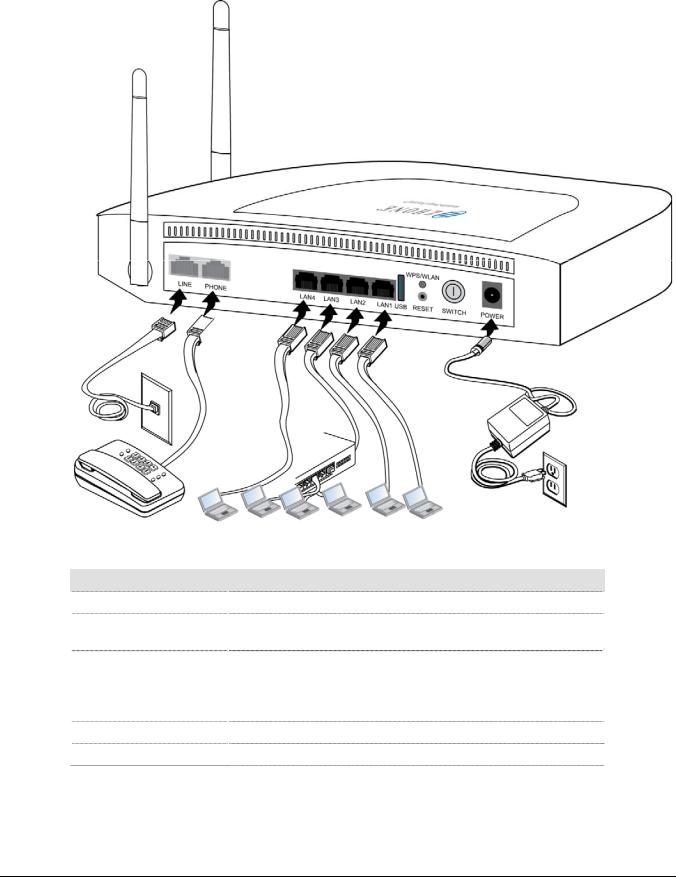
Back Panel
NOTE: The below port descriptions are listed as they appear on the back panel from left to right.
Port
DSL
LAN1 – LAN4
Reset / Default
Power
Switch
Description
RJ-11 cable connects to incoming DSL line
RJ-45 connects the unit to an Ethernet device such as a PC or a switch.
Restart—press the button for less than 4 seconds.
ISP settings—press the button for 4 seconds or longer.
Factor y Default settings – press the button for 60 seconds or longer
Connects to a 12V 700 mA power adapter.
Power on (depressed) or power off for the router.
NOTE: The 6512 and 6511 do not have the wireless antenna. The 6511 has one LAN port.
65xx-A1 Family Router Users Guide 16

Chapter 2 Hardware Installation and PC Setup
Overview
This chapter provides basic instructions for connecting the router to a computer or a LAN and to the Internet using DSL. The first part provides instructions to set up the hardware, and the second part describes how to prepare your PC for use with the router. Refer to Chapter 3, Using the Web Interface for configuration instructions.
It is assumed that you have already subscribed to DSL service with your telephone company or other Internet service provider (ISP).
Connecting Your Hardware
Shut down your PC before connecting the router. To connect your modem:
1.Connect the ADSL Line
Connect one end of an RJ-11 cable from your ADSL connection and the other end to the LINE port of the modem.
2.Connect the PC to the Router
To use the Ethernet connection, connect the Ethernet cable from the computer directly to the router. Connect one end of the Ethernet cable to one of the four ports labelled LAN on the back of the router and attach the other end to the Ethernet port of your computer.
65xx-A1 Family Router Users Guide 17

3.Connect the Power Adapter
Complete the process by connecting the AC power adapter to the POWER connector on the back of the device and plug the adapter into a wall outlet or power strip. Then turn on and boot up your PC and any LAN devices, such as hubs or switches, and any computers connected to them.
Mounting the Router
The router can be mounted on the wall with two screws. Mounting can be done on wall material including concrete, wood, or drywall. Select an appropriate location free from obstructions or any possible interference. Make sure the cables can be easily attached to the router without strain. The illustration below shows how to mount the router horizontally on a wall.
NOTE: Mount the router with the cables facing down, the LEDs facing up.
65xx-A1 Family Router Users Guide 18
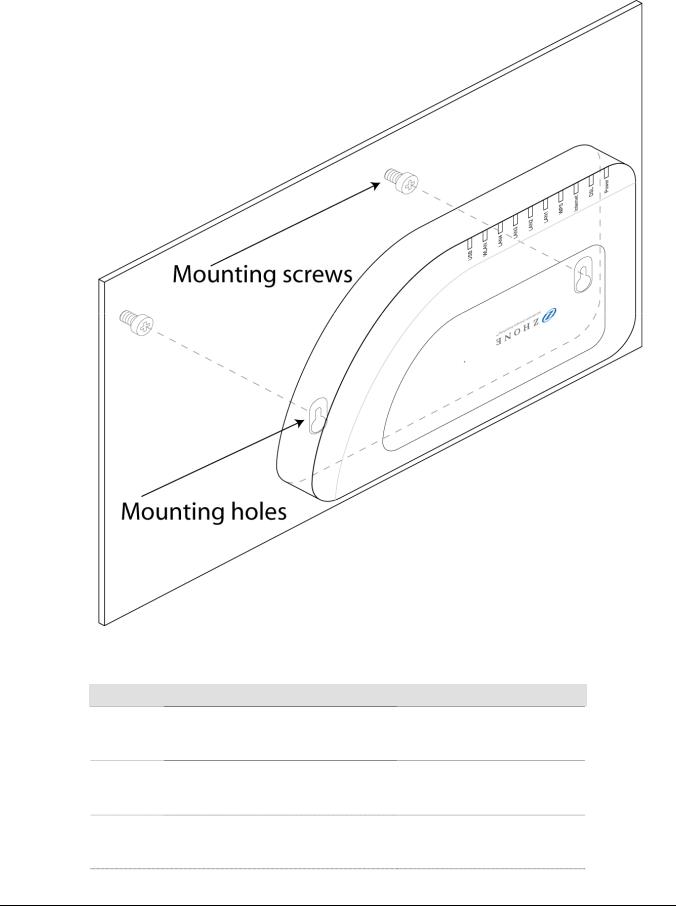
Unit dimensions
Model
6511-A1
6512-A1
6518-A1
Unit Dimensions
1.30" (H) x 7.25" (W) x 5" (D)
34.93 mm (H) x 184.15mm (W) x 127mm
(D)
1.25"(H) x 8.25" (W) x 4.75" (D)
31.75 mm (H) x 209.55 mm (W) x 102.65 mm (D)
1.25" (H) x 8.25" (W) x 4.75" (D)
31.75 mm (H) x 209.55 mm (W) x 102.65
(D)
Mounting Holes
2 holes- 5.375" (136.63mm) apart
2 holes 6.125" (155.58mm) apart
2 holes 6.125" (155.58mm) apart
65xx-A1 Family Router Users Guide 19

Model |
Unit Dimensions |
Mounting Holes |
|
1.25" (H) x 8.25" (W) x 4.75" (D) |
2 holes 6.125" (155.58mm) |
6519-X1 |
31.75 mm (H) x 209.55 mm (W) x 102.65 |
apart |
|
(D) |
|
Configuring Your Computer
Prior to accessing the router through the LAN or the USB port, note the following necessary configurations—
•Your PC’s TCP/IP address: 192.168.1.__( the last number is any number between 2 and 254)
•The router’s default IP address: 192.168.1.1
•Subnet mask: 255.255.255.0
Below are the procedures for configuring your computer. Follow the instructions for the operating system that you are using.
If you used the Ethernet cable to connect your router and PC, you do not need any specific driver installation.
Windows 2000
1.In the Windows taskbar, click the Start button and point to Settings, Control Panel, and
Network and Dial-up Connections (in that order).
2.Click Local Area Connection. When you have the Local Area Connection Status window open, click Properties.
3.Listed in the window are the installed network components. If the list includes Internet Protocol (TCP/IP), then the protocol has already been enabled, and you can skip to Step 10.
4.If Internet Protocol (TCP/IP) does not appear as an installed component, then click Install.
5.In the Select Network Component Type window, click on protocol and then the Add button.
6.Select Internet Protocol (TCP/IP) from the list and then click on OK.
7.If prompted to restart your computer with the new settings, click OK.
8.After your computer restarts, click the Network and Dial-up Connections icon again, and right click on the Local Area Connection icon and then select Properties.
9.In the Local Area Connection Properties dialog box, select Internet Protocol (TCP/IP) and then click Properties.
10.In the Internet Protocol (TCP/IP) Properties dialog box, click the radio button labelled Use the following IP address and type 192.168.1.x (where x is any number between 2 and 254) and 255.255.255.0 in the IP address field and Subnet Mask field.
11.Click OK twice to save your changes and then close the Control Panel.
65xx-A1 Family Router Users Guide 20

Windows XP
1.In the Windows taskbar, click the Start button and point to Settings and then click Network Connections.
2.In the Network Connections window, right click on the Local Area Connection icon and click on Properties.
3.Listed in the Local Area Connection window are the installed network components. Make sure the box for Internet Protocol (TCP/IP) is checked and then click Properties.
4.In the Internet Protocol (TCP/IP) Properties dialog box, click the radio button labelled Use the following IP address and type 192.168.1.x (where x is any number between 2 and 254) and 255.255.255.0 in the IP address field and Subnet Mask field.
5.Click OK twice to save your changes and then close the Control Panel.
Windows 7
1.In the Windows taskbar, click the Start button and point to Control Panel and then click
Network and Internet.
2.In the Network and Internet window, click Network and Sharing Center.
3.In the left panel click Change adapter settings.
4.In the Network Connections screen, right click Local Area Connection and select Properties.
5.Listed in the Local Area Connection window are the installed network components. Select
Internet Protocol Version 4 (TCP/IP v4) is checked and then click Properties.
6.In the Internet Protocol Version 4 (TCP/IP v4) dialog box, click the radio button labelled Use the following IP address and type 192.168.1.x (where x is any number between 2 and 254) and 255.255.255.0 in the IP address field and Subnet Mask field.
7.Click OK the Close to save your changes and then close the Control Panel.
65xx-A1 Family Router Users Guide 21

Chapter 3 The Web User Interface
The 65xx-A1 family of combination modem/routers have a Wide Area Network (WAN) connection which connects to your phone line. This connects to your Internet Service Provider (ISP) via the phone line. The Local Area Network (LAN) connections are where you plug in your local computers to the router. The 6518-A1 also has a wireless interface. The router is normally configured to automatically provide all the PCs on your network with Internet addresses.
Your router may be pre-configured with your ISP configuration to ease your installation. Please contact your ISP if you need information on how to connect the modem to your ISP. To set up your router with a basic configuration required by your service provider, you can use the Quick Setup form the top of the navigation bar. In order for this to work, all other WAN services must first be removed. To remove services, from the top navigation bar select Quick Setup.
If you connected a PC (rather than a hub or a switch) directly to the router, your LAN consists of that PC. You may also create connections for various protocol options by creating new connections.
To configure your router you will first need to log in to the router.
Note: Before configuring your router, make sure you have followed the instructions in Chapter 2 Hardware Installation and PC Setup. You should have your PCs configured for DHCP mode (if your router will be), and have proxies disabled on your browser. If you see a login redirection screen when you access the web interface, verify that JavaScript support is enabled in your browser. Also, if you do not get the screen shown below, you may need to delete your temporary Internet files.
Log in to the Router
This section will explain how to log in to your router.
1.Launch your web browser.
2.Enter the URL http://192.168.1.1 in the address bar and press Enter.
A login screen like the one below will be displayed after you connect to the user interface.
15xx-A1 Family Router Users Guide 22

3.Enter your user name and password, and then click on OK to display the user interface.
The user name / password are admin / admin and both are case sensitive.
Note: For security reasons you should change your password as soon as possible.
Note: There are three default user name and password combinations; Admin, Support, and User. The user / user name and password combination can display device status, but cannot change or save configurations. The admin / admin combination can perform all functions. Passwords can be changed at
any time.
For information about password administration, see Passwords on page 130.
Summary
Access the general information of the router by clicking Summary under Device Info. This screen shows details of the router such as the version of the software, bootloader, LAN IP address, etc. It also displays the current status of your DSL connection as shown below.
65xx-A1 Family Router Users Guide 23
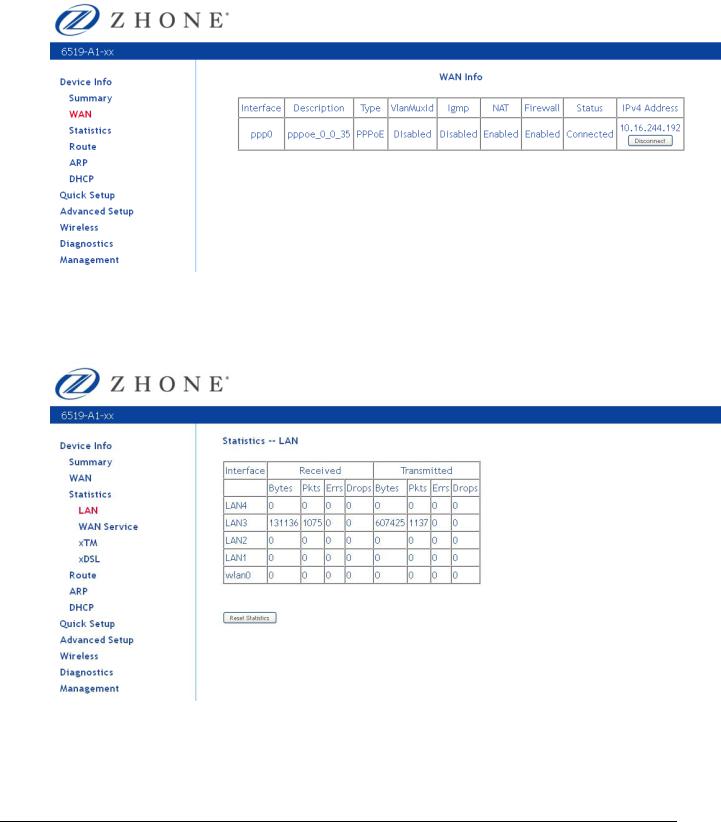
WAN
Display the WAN status report from the router by clicking WAN under Device Info. The graphic below shows the screen when a WAN connection is set up.
LAN Statistics
Display LAN statistics by clicking LAN under Statistics
65xx-A1 Family Router Users Guide 24

WAN Statistics
Display WAN statistics by clicking WAN Service under Statistics.
xTM Statistics
Display ATM statistics by clicking xTM under Statistics.
65xx-A1 Family Router Users Guide 25
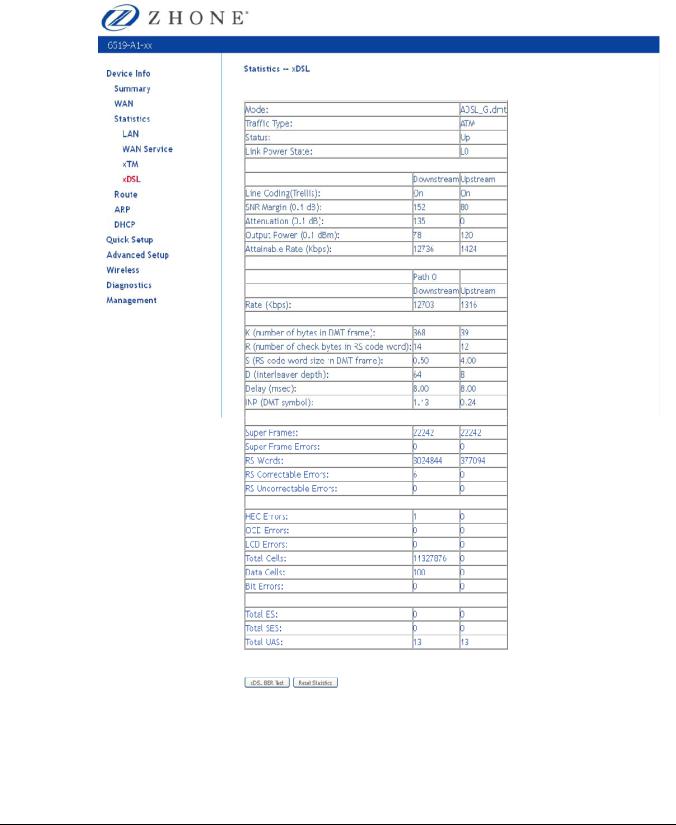
xDSL Statistics
Display ADSL statistics by clicking xDSL under Statistics. Information contained in this screen is useful for troubleshooting and diagnostics of connection problems.
ADSL BER Test
The ADSL Bit Error Rate (BER) test determines the quality of the ADSL connection. The test is performed by transferring idle cells containing a known pattern and comparing the received data with this known pattern to check for any errors The BER Test reflects the ratio of error bits to the total number transmitted.
65xx-A1 Family Router Users Guide 26

If you click on the ADSL BER Test button at the bottom of the ADSL Statistics page, the following pop-up screen will appear allowing you to set the tested time and to begin the test.
To run a BER test:
1.On the bottom of the xDSL statistics page, click xDSL BER Test
2.In the Tested Time (sec) drop down, select the test duration, and then click Start.
3.Check the results.
Route
Access the routing status report from the router by clicking Route under Device Info.
65xx-A1 Family Router Users Guide 27
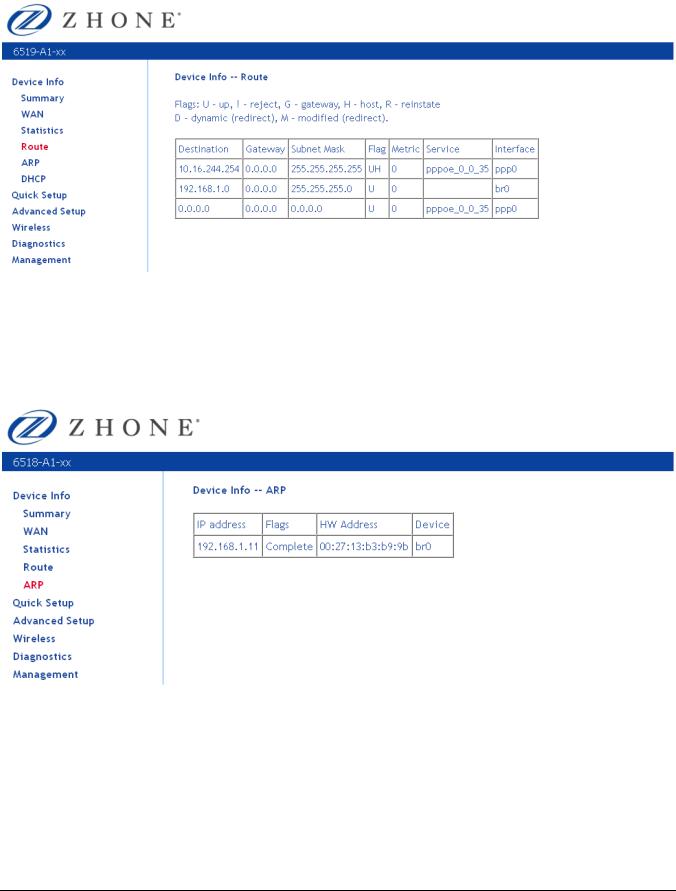
ARP
Display the ARP status report by clicking ARP under Device Info.
ARP (Address Resolution Protocol) maps the IP address to the physical address, labelled HW Address (the MAC address) and identifies computers on the LAN.
DHCP
Display the DHCP lease information by clicking DHCP under Device Info.
DHCP (Dynamic Host Control Protocol) allows the modem to automatically assign IP addresses, to connected devices. By default, your modem is set up to assign devices addresses from 192.168.1.2 to 192.168.1.254.
65xx-A1 Family Router Users Guide 28
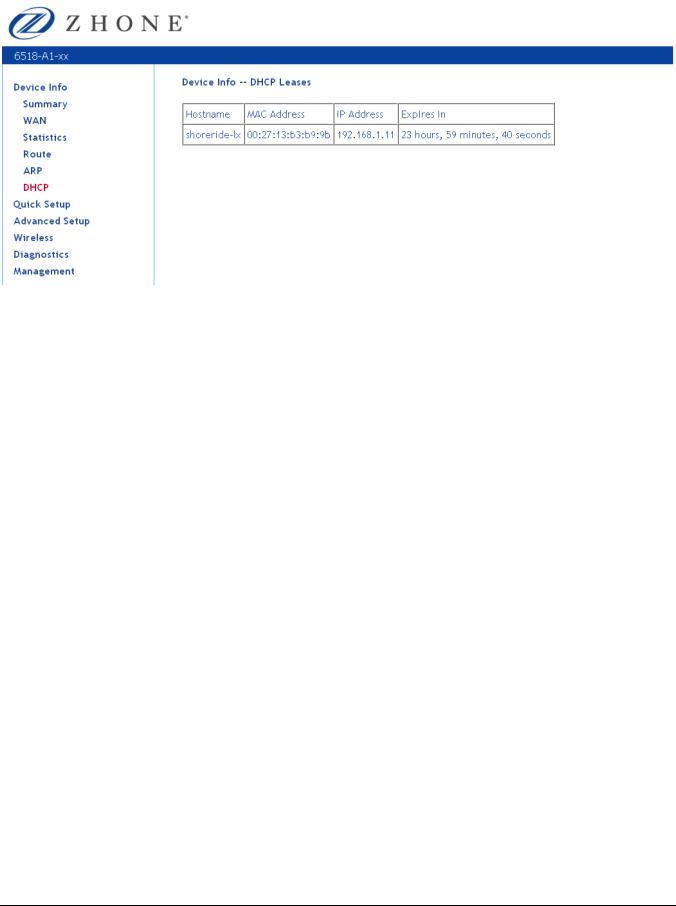
65xx-A1 Family Router Users Guide 29
